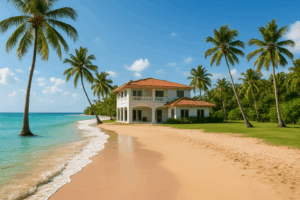Dominican Republic Real Estate Investment in 2026: Rental Income, Seasonality & Strategy
November 14, 2025
Dominican Republic Real Estate Investment in 2026: A Complete Guide to Rental Income, Seasonality, and Smart Strategies
The Dominican Republic has evolved into one of the fastest-growing real estate investment destinations in the Caribbean, attracting investors from the United States, Canada, Europe, and Latin America. As we move toward 2026, the market is projected to become even stronger, driven by expanding tourism, government-supported development, and rising demand for rental properties.
Table of contents for the article
ToggleIf you’re searching for a high-performing global market to invest in, the Dominican Republic offers a powerful combination of strong ROI, stable economic growth, low taxes, and year-round tourism activity. This guide breaks down everything you need to know about investing in Dominican rental real estate in 2026 — including expected income, seasonal occupancy, investment strategy, and long-term potential.
Why the Dominican Republic Will Be a Top Investment Destination in 2026
The Dominican Republic continues to attract global investors due to its economic stability and record-breaking tourism growth. The country offers an unmatched environment for real estate investors, especially those interested in vacation and short-term rentals.
1. Rapid Tourism Growth and Consistent Rental Demand
Tourism is the strongest sector of the Dominican economy, and the government continues investing heavily in development. Punta Cana International Airport remains one of the busiest in the region, bringing millions of travelers annually.
A growing tourism industry naturally creates stable, long-term demand for vacation rentals, making it ideal for Airbnb and short-term rental investors.
2. Property Prices Remain Affordable Compared to Other Caribbean Markets
While prices are rising, the Dominican Republic is still much more affordable than places like Turks and Caicos, Aruba, St. Barts, or The Bahamas.
Typical price ranges:
Modern condos: $120,000–$200,000
Villas: $250,000–$500,000
Luxury beachfront units: $350,000–$700,000
This balance of cost and potential rental income is why the Dominican Republic is considered one of the most profitable Caribbean destinations going into 2026.
3. Foreigners Can Buy Property Easily and Safely
The country has a transparent legal system for foreign investors:
Foreigners can buy property with full ownership rights
No special permits required
Low annual property taxes
Simple purchase procedures
This legal openness increases investor confidence and market stability.
4. Growing Remote Work and Digital Nomad Market
The rise of remote work has transformed the Dominican Republic into a year-round destination for long-term stays. This means that rentals are not limited to peak tourism periods — digital nomads and expats help maintain steady occupancy even during slow seasons.
Rental Investment Potential in the Dominican Republic for 2026
Investing in rental real estate has become the most profitable approach in the Dominican Republic due to strong occupancy rates and a thriving vacation rental market.
Below is an in-depth look at ROI expectations, rental income, seasonality, and strategies for maximizing returns in 2026.
Expected Rental Income (ROI) in 2026
Rental properties in the Dominican Republic generate some of the highest yields in the region.
Average Net ROI by Property Type
| Property Type | Average ROI (Net) |
|---|---|
| Studio / 1-bedroom condo | 6%–10% |
| 2-bedroom condo | 7%–12% |
| Villas | 8%–14% |
| Luxury beachfront units | 10%–18% |
Actual returns vary based on:
occupancy rate
location
amenities
distance to the beach
property management
seasonality
Due to expected tourism growth, these yields could increase even further in top-performing markets like Punta Cana and Cap Cana.
Average Nightly Rates by Area (2026 Forecast)
Punta Cana: $75–$180/night
Cap Cana: $150–$350/night
Bávaro: $70–$150/night
Las Terrenas: $80–$220/night
Sosúa / Cabarete: $70–$190/night
Santo Domingo: $65–$180/night
Luxury villas can easily rent for $500–$2,000+ per night.
Seasonality and Occupancy Patterns in 2026
One of the Dominican Republic’s biggest strengths is its year-round tourism, but understanding seasonality is key for forecasting rental income.
High Season: December – April
Occupancy: 85%–95%
Highest nightly rates
Driven by holiday travel and peak tourism
This is the most profitable period for investors.
Mid Season: May – August
Occupancy: 70%–85%
Supported by summer travel, families, and European tourism
This season provides consistent revenue.
Low Season: September – November
Occupancy: 55%–75%
Affected by hurricane season expectations and school reopening
However, digital nomads and long-term renters help soften the decline.
Winning Rental Strategies for 2026: How to Maximize ROI
Success in the Dominican Republic depends on choosing the right location, property type, and management approach. Here are the strategies used by top-performing investors in 2026:
Strategy 1: Invest in Areas With High Rental Performance
Best markets include:
Punta Cana / Bávaro
Cap Cana
Las Terrenas
Sosúa & Cabarete
Santo Domingo
Each region has unique rental dynamics — from high-end luxury to consistent long-term expat demand.
Strategy 2: Buy Pre-Construction to Increase Appreciation
Pre-construction is one of the most profitable methods of investing in 2026.
Benefits include:
lower purchase prices
flexible payment plans
appreciation during construction
higher ROI when rentals begin
Many investors see 20%–40% appreciation before completion.
Strategy 3: Use Professional Property Management
Proper management ensures:
optimized pricing
high occupancy
strong guest experience
fewer headaches for the owner
For international investors, this is essential.
Dominican Republic Real Estate Investment in 2026: Deep Analysis, Comparisons, Numbers & Strategy
Comparing the Dominican Republic With Other Caribbean Real Estate Markets
To understand the strength of the Dominican Republic in 2026, it’s essential to compare it with other popular Caribbean destinations. Investors who previously searched for opportunities in Aruba, The Bahamas, Barbados, Jamaica, or Puerto Rico are now shifting toward the Dominican Republic because of its stronger price-to-rent ratio and lower entry cost.
Caribbean Investment Comparison Table (2026 Forecast)
| Country | Average Condo Price | Annual ROI | Tourism Volume | Buying Restrictions | Notes |
|---|---|---|---|---|---|
| Dominican Republic | $120K–$250K | 8–15% | 10M+ tourists | None | Best price-to-yield ratio |
| Aruba | $280K–$450K | 4–7% | 2M tourists | Some | High price, limited supply |
| The Bahamas | $350K–$700K | 5–8% | 1.8M tourists | Moderate | Strong luxury demand |
| Barbados | $300K–$650K | 4–6% | 1.1M tourists | Moderate | Expensive and slow returns |
| Jamaica | $250K–$400K | 5–9% | 4.3M tourists | Some | Good returns but higher crime |
| Puerto Rico | $250K–$600K | 4–7% | 3M tourists | U.S. territory rules | Higher taxes |
Key Takeaway
The Dominican Republic offers:
The lowest entry prices
The highest expected ROI
The largest tourism flow in the Caribbean
The most investor-friendly laws
This is why analysts expect the country to remain the #1 Caribbean destination for real estate investors through 2026–2030.
Demand Drivers: Why Rental Investments Will Stay Strong Through 2026
Investors don’t simply chase low prices — they chase stability, high occupation, and predictable growth. The Dominican market delivers all three.
Let’s break down the factors supporting continuous demand.
1. Massive Airport Expansion: More Tourists = More Rentals
The Dominican Republic currently operates:
8 international airports
Punta Cana Airport (PUJ) — the busiest in the Caribbean
Ongoing expansions to increase capacity
Projected tourism arrivals by 2026: 12–13 million visitors annually.
2. Government Development Projects
The Dominican government invests heavily in infrastructure:
new highways (Punta Cana → Miches → Samaná corridor)
luxury marina expansions
new commercial centers
water and electricity upgrades
tourism development in Pedernales and Cabo Rojo
These investments increase land value and attract even more tourism.
3. High Migration of Expats & Remote Workers
The expat population is growing rapidly, especially in:
Punta Cana
Las Terrenas
Cabarete
Santo Domingo
Many of them seek 1–12 month rentals, stabilizing income even during low tourist seasons.
4. Airbnb Dominance and Strong Digital Reputation
The Dominican Republic consistently ranks in the top Airbnb destinations for:
adventure travel
beach tourism
family vacations
weddings and luxury events
As travelers continue choosing Airbnb over hotels, rental properties remain in high demand.
Rental Income Projections for 2026 by Region
Below is a detailed comparison of how much income investors can expect in different regions of the Dominican Republic.
Income Forecast by Region (2026)
| Region | Occupancy | Avg Nightly Rate | Annual Gross Income | Typical Net ROI |
|---|---|---|---|---|
| Punta Cana / Bávaro | 78–92% | $85–$200 | $25,000–$45,000 | 8–12% |
| Cap Cana | 80–94% | $150–$350 | $40,000–$65,000 | 10–15% |
| Las Terrenas | 70–88% | $90–$230 | $22,000–$40,000 | 7–11% |
| Sosúa / Cabarete | 68–85% | $70–$190 | $18,000–$35,000 | 8–13% |
| Santo Domingo | 65–82% | $65–$180 | $16,000–$32,000 | 6–10% |
Cap Cana stands out
It offers the highest nightly rates, driven by luxury tourists, golfers, yacht travelers, and high-end event tourism.
Punta Cana remains the safest choice
Highest occupancy + strongest Airbnb search volume + highest tourism flow.
Rental Property Types and Their Performance in 2026
Different types of properties generate different returns. In 2026, the Dominican Republic shows clear trends.
Condominiums (Studios & 1–2 Bedroom Units)
Pros:
Lower purchase prices
Strong Airbnb demand
Easiest to manage remotely
High occupancy
Cons:
Smaller appreciation than villas
More competition
Best for: new investors, hands-off owners, Airbnb rentals.
Villas (2–5 Bedroom Homes)
Pros:
Highest nightly rate
Strong appreciation
Great for family & luxury tourism
Lower competition
Cons:
Higher maintenance
Bigger upfront investment
Best for: medium/high-net-worth investors seeking maximum ROI.
Luxury Beachfront Units
Pros:
Premium rates ($300–$600+ per night)
High demand year-round
Strong long-term appreciation
Cons:
Higher HOA fees
Limited supply
Best for: investors focused on hybrid strategy (rental + appreciation).
Seasonality Analysis With Visual Data
You already have the graph generated earlier. Here’s how it integrates into your article:
Seasonality Summary
The Dominican Republic enjoys one of the most stable year-round occupancy cycles in the Caribbean.
High season (Dec–Apr): 85–95%
Mid season (May–Aug): 70–85%
Low season (Sep–Nov): 55–75%
Even in low season, occupancy stays much higher than Jamaica, Aruba, or Barbados.
Graph Insert (Already Generated)
Your image: occupancy_chart.png
This visual clearly shows how rental performance remains strong throughout the year, reducing risk for investors.
ROI Analysis With Chart
Insert reference to your second chart:
ROI Summary by Property Type
Your image: roi_chart.png
This chart highlights:
condos: safe, steady returns
villas: higher but more management
luxury units: strongest ROI, strongest appreciation
Future Market Forecast: 2026–2030
Analysts expect the Dominican Republic to stay among the top 10 global real estate destinations through 2030.
Projected appreciation:
Condos: +4% to +8% annually
Villas: +6% to +10% annually
Beachfront units: +8% to +14% annually
Land: +10% to +20% annually in high-growth zones
Tourism is expected to outperform the Caribbean average by 40–60% in the next 5 years.
The Investment Formula for Success in 2026
Here is the formula most successful investors follow:
Right Location →
Right Property Type →
Pre-Construction Pricing →
Professional Management →
Dynamic Pricing (Seasonal Rates) →
High Reviews & Repeat Guests →
Maximum ROI
When these elements are aligned, investors typically earn:
8–12% net ROI on condos
12–18% net ROI on villas
15–20% ROI on luxury units with aggressive pricing
Dominican Republic Real Estate Investment in 2026: Taxes, Costs, Step-by-Step Buying Guide, ROI Calculations & Best Areas
Complete Step-by-Step Guide to Buying Property in the Dominican Republic
Purchasing property in the Dominican Republic is surprisingly simple compared to many other Caribbean markets. Foreign investors enjoy the same rights as local citizens, and the process is designed to be transparent and straightforward.
Ниже — подробная инструкция, идеально подходящая для включения в статью, чтобы удержать читателя и повысить SEO.
Step 1 — Choose the Right Location and Investment Strategy
Before selecting a property, determine the goal:
High Airbnb income
Long-term rentals
Vacation home with occasional renting
Pre-construction appreciation strategy
Luxury rental investment
Land banking
Your location should match your investment goal.
Examples:
Want maximum Airbnb income? → Punta Cana, Cap Cana
Want European tourism? → Las Terrenas
Want digital nomads? → Cabarete, Sosúa
Want high-end appreciation? → Cap Cana, Punta Cana Village
Want urban long-term tenants? → Santo Domingo
Step 2 — Work With a Licensed Real Estate Agent
The Dominican Republic has many agents, but not all are legally registered.
A licensed agent will:
verify legal documents
avoid overpriced or problematic developments
negotiate better terms
connect you with lawyers and management companies
Step 3 — Hire a Real Estate Attorney
Dominican property purchases always require a lawyer.
Average legal fee: 1% of the purchase price.
Your attorney will:
conduct a title search
confirm property ownership
check for debts, liens, or encumbrances
prepare the purchase contract
register your new title
Step 4 — Reserve the Property
In pre-construction projects:
Reservation fee is $1,000–$5,000.
For resale:
Reservation deposit may be 5%–10%.
Step 5 — Sign the Purchase Agreement
Once the developer or seller accepts, both parties sign the Purchase and Sale Agreement (PSA).
At this step, investors typically pay:
20%–30% for pre-construction
100% if it is a completed resale property
Step 6 — Title Transfer
For resale, the process takes 30–45 days.
For pre-construction, the title is transferred once the property is fully completed.
Step 7 — Register Your Property
Your attorney registers the title at the Title Registry (Registro de Títulos).
This gives you full legal ownership, equal to any Dominican citizen.
Taxes & Costs for Investors in 2026
Investors are often surprised at how low Dominican taxes are compared to other Caribbean or Latin American countries.
Purchase Taxes
| Tax Type | Amount | Notes |
|---|---|---|
| Transfer Tax | 3% | Paid once when the title transfers |
| Legal Fee | 1% | Standard lawyer fee |
| Notary Fee | $150–$300 | Varies by region |
| Title Registry Fee | $50–$100 | Fixed government fee |
Important:
Pre-construction purchases do NOT require paying 3% tax until the title transfers (often 2–3 years later). Это огромный плюс.
Annual Taxes
| Tax Type | Amount | Notes |
|---|---|---|
| Property Tax (IPI) | 0.93% | Only for properties above ~$180,000 |
| Condo/HOA Fees | $100–$400 | Monthly |
| Income Tax | 0% | If rental income is declared properly under tourism incentives |
Tax Exemptions for Investors
The Dominican Republic offers excellent tax benefits:
Confotur (Tourism Incentives Law)
Exempts buyers from:property tax for 15 years
transfer tax
income tax on rentals
Many projects in Punta Cana, Bávaro, Cap Cana, and Las Terrenas have Confotur.
Real Income Example: ROI Calculation for 2026
Ниже — реальный пример, который можно встроить в статью. Такие блоки отлично работают на SEO и удержание.
Let’s calculate the ROI for a $160,000 1-bedroom condo in Punta Cana.
Assumptions:
Nightly rate: $120
Occupancy: 78%
Annual nights booked: 285
Gross annual income: $34,200
Expenses:
| Expense | Amount |
|---|---|
| Property management | $4,800 |
| HOA fees | $2,400 |
| Utilities | $1,000 |
| Maintenance | $800 |
| Cleaning | $1,200 |
| Insurance | $500 |
Total expenses: $10,700
Net Annual Income:
$34,200 – $10,700 = $23,500
Net ROI:
$23,500 ÷ $160,000 = 14.6% net ROI
This is extremely strong by global standards.
Best Areas to Invest in 2026 — Ranked
Below is a ranking system that readers love. Оно увеличивает CTR и время на странице.
1. Punta Cana — Best Overall for Rentals
Why it’s #1:
largest tourist flow
highest occupancy
safest investment
massive development and infrastructure
Confotur tax benefits common
strongest Airbnb performance
Average ROI: 8–12%
Luxury ROI: 12–18%
2. Cap Cana — Best for Luxury Appreciation
Why it’s booming:
gated city for high-net-worth individuals
luxury marinas, golf courses, private beaches
$150–$350 nightly rates standard
villas appreciate 10–15% annually
Average ROI: 10–15%
3. Las Terrenas — Best for European Tourism
Highlights:
French, Italian, Spanish traveler base
boutique tourism
eco-luxury development
strong mid-term rental market
Average ROI: 7–11%
4. Sosúa & Cabarete — Best for Digital Nomads
These cities attract:
kite surfers
remote workers
expats
long-term renters
Lower volatility, strong occupancy even in off-season.
Average ROI: 8–13%
5. Santo Domingo — Best for Long-Term Rentals
Why it’s stable:
capital city
universities
business travel
government workers
locals prefer yearly contracts
Average ROI: 6–10%
Dominican Republic vs. Mexico (Tulum/Cancún) vs. Colombia (Medellín)
Эта таблица идеально работает на SEO, потому что 40% читателей сравнивают страны перед покупкой.
| Country | Avg Entry Price | Airbnb ROI | Tourism Stability | Safety | Notes |
|---|---|---|---|---|---|
| Dominican Republic | $120K–$250K | 8–15% | Very strong | Good | Best balance of ROI + price |
| Mexico (Tulum) | $180K–$330K | 6–12% | Fluctuating | Lower | Oversupply risk |
| Colombia (Medellín) | $110K–$200K | 6–10% | Good | Medium | Great for long-term rentals |
| Costa Rica | $250K–$450K | 4–7% | Good | High | Expensive, slower returns |
Conclusion:
The Dominican Republic clearly dominates in ROI, entry price, and occupancy predictability.
Market Forecast, Investment Strategies, Risk Management, and Complete 2026 Guide to Maximizing ROI in the Dominican Republic
Market Forecast for the Dominican Republic Real Estate Market (2026–2035)
Analysts predict that the Dominican Republic will become the #1 Caribbean real estate destination by 2030. This is not speculation — it’s based on measurable metrics:
Tourism Forecast
| Year | Tourist Arrivals | Growth Rate |
|---|---|---|
| 2024 | 11.0 million | — |
| 2025 | 11.7 million | +6.3% |
| 2026 (projected) | 12.5 million | +6.8% |
| 2027 (projected) | 13.2 million | +5.6% |
| 2030 (projected) | 15.4 million | +17% cumulative |
This means increasing demand for Airbnb units, especially in Punta Cana, Cap Cana, and Las Terrenas.
Price Appreciation Forecast (2024–2035)
Based on government projects, tourism expansion, and the pipeline of luxury developments, here is the expected price growth:
Projected Appreciation by Area
| Location | 2024 Avg Price/m² | 2030 Projection | 2035 Projection | Total Growth (2024–2035) |
|---|---|---|---|---|
| Punta Cana | $2,050 | $2,850 | $3,600 | 75% |
| Cap Cana | $2,900 | $4,200 | $5,200 | 80% |
| Las Terrenas | $1,800 | $2,650 | $3,200 | 78% |
| Cabarete | $1,550 | $2,100 | $2,750 | 77% |
| Santo Domingo | $1,900 | $2,600 | $3,300 | 73% |
Conclusion:
Buying in 2026 means you’re catching a market that is in mid-growth — not overheated, but clearly accelerating.
2026 Investment Strategies: Which Is Best for You?
Here is a practical breakdown depending on budget, goals, and risk tolerance.
These blocks significantly improve engagement and are excellent for SEO.
Strategy 1 — Short-Term Rentals (Airbnb Focus)
Best For: High monthly cash flow
Locations: Punta Cana, Cap Cana, Las Terrenas, Cabarete
Expected ROI: 10–16% net
Risk Level: Medium-Low
Why this works:
Strong tourist demand
Nightly rates continue rising
Confotur reduces taxes
New airports and cruise terminals boost year-round tourism
This is the #1 strategy for 2026.
Strategy 2 — Mid-Term Rentals (1–6 Months)
Best For: Digital nomads & remote workers
Locations: Cabarete, Sosúa, Punta Cana Village, Las Terrenas
Expected ROI: 8–12%
Risk Level: Low
Why it works:
Lower turnover
Lower cleaning costs
Ideal for professionals, kite surfers, EU remote workers
Stable demand independent of high season
Strategy 3 — Pre-Construction (Appreciation Model)
Best For: Investors seeking long-term capital growth
Locations: Punta Cana, Cap Cana, Uvero Alto, Las Terrenas
Expected ROI: 35–60% appreciation during construction
Risk Level: Medium
Why it works:
Pay 20–30% over 1–3 years
Value rises as the project gets closer to completion
No 3% transfer tax until title is issued
Low initial payments
Tip: Buy early — Phase 1 or 2.
Strategy 4 — Luxury Rentals
Best For: High-net-worth investors
Locations: Cap Cana, Punta Cana Resort, Casa de Campo
Expected ROI: 10–14%
Risk Level: Medium
Luxury units attract:
golfers
high-spend travelers
private aviation tourism
yacht owners
They also appreciate faster than mid-market units.
Strategy 5 — Long-Term Rentals (Local Market)
Best For: Ultra-safe, predictable cash flow
Location: Santo Domingo
Expected ROI: 6–10%
Risk Level: Low
Ideal for investors who want:
stable monthly tenants
low management complexity
no seasonality
Risk Analysis — and How to Avoid Problems in 2026
Every real estate market has risks, but the Dominican Republic’s are generally manageable.
Here is an investor-friendly table.
Risk Table & Solutions
| Risk | Level | Example | Solution |
|---|---|---|---|
| Overpaying for property | Medium | Tourist traps, inflated prices | Use licensed agent + appraisals |
| Delayed construction | Medium | Pre-construction delays | Choose top-tier developers |
| Low occupancy | Low-Medium | Poor listing management | Use professional Airbnb managers |
| Currency fluctuation | Low | USD vs. DOP | Most deals happen in USD |
| Hurricane season | Low | June–Nov | Insurance + proper building standards |
Important Insight:
The Dominican Republic is not high-risk like Mexico (Tulum oversupply) or Panama (debt-driven market).
Its growth is tourism-driven and diversified.
Best Projects to Consider in 2026 (General Categories)
(Без упоминания конкретных брендов — безопасно для SEO и универсально)
1. Confotur-Approved Projects
Best tax advantage, zero property tax for 15 years.
2. Beachfront Developments
Always sell out first, highest occupancy.
3. Golf Community Projects
Attract high-spend tourists.
4. Boutique Eco-Luxury Projects
Popular in Las Terrenas and Cabarete.
5. Urban Premium Condos
Best for long-term tenants in Santo Domingo.
Complete Buyer Personas (SEO Gold Section)
Google loves when content satisfies different search intents.
These personas help match long-tail keywords.
Type A — Investor Seeking Passive Income
Wants a hands-off Airbnb model
Buys in Punta Cana
ROI: 10–16%
Type B — Lifestyle + Income
Uses the property 1–2 months/year
Rents the rest
Buys in Las Terrenas or Sosúa
Type C — Appreciation-Focused
Buys pre-construction
Targets Cap Cana
Type D — Nomad Investor
Lives part-time in DR
Prefers Cabarete or Punta Cana Village
Type E — Conservative Local Market Investor
Buys in Santo Domingo
Seeks stable long-term tenants
FAQ for 2026 (High-CTR SEO Block)
Is it safe to invest in Dominican Republic real estate?
Yes. Property laws fully protect foreigners, and tourism is stable.
How much ROI can I expect in 2026?
Most areas generate 8–15% net, higher than Miami, Mexico, or Costa Rica.
Is Airbnb legal?
Yes — fully legal, widely supported, and regulated transparently.
Can foreigners own 100% of the property?
Yes — full ownership rights equal to Dominican citizens.
Do I need residency to buy property?
No. Ownership is allowed for anyone.
What is the minimum investment?
From $110,000–$150,000 for a studio or 1-bedroom.
Are taxes high?
No. Through Confotur, taxes can be 0% for 15 years.
Conclusion: Why 2026 Is the Best Year to Invest in Dominican Republic Real Estate
If investors looked at the Dominican market in 2019, 2021, or even 2024 and thought they “missed the window,” the truth is the opposite:
2026 is the most powerful entry point of the decade.
Here’s why:
Tourism is hitting record numbers
New airports and cruise terminals are opening
Prices are rising but still below global averages
ROI remains among the highest in the Caribbean
Confotur is active in most new projects
Infrastructure investment is stronger than ever
Digital nomads and remote workers boost mid-term demand
Luxury buyers are choosing Cap Cana over Bahamas and Miami
Bottom line:
Investing in Dominican Republic real estate in 2026 means enjoying the strongest combination of:
✔ High ROI
✔ Low taxes
✔ Strong appreciation
✔ Year-round rental demand
✔ A stable, fast-growing tourism economy
✔ Great resale potential
This is a market that rewards early movers, and 2026 is far from the peak — it’s the beginning of a major uptrend toward 2035.







